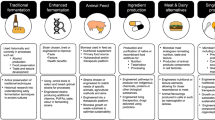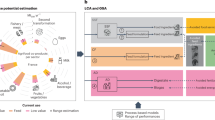Abstract
Climate change-induced alterations in weather patterns, such as frequent and severe heatwaves, cold waves, droughts, floods, heavy rain and storms, are reducing crop yields and agricultural productivity. At the same time, greenhouse gases arising from food production and supply account for almost 30% of anthropogenic emissions. This vicious circle is producing a global food crisis. Sustainable food resources and production systems are needed now, and microbial foods are one possible solution. In this Perspective, we highlight the most promising technologies, and carbon and energy sources, for microbial food production.
This is a preview of subscription content, access via your institution
Access options
Access Nature and 54 other Nature Portfolio journals
Get Nature+, our best-value online-access subscription
$29.99 / 30 days
cancel any time
Subscribe to this journal
Receive 12 digital issues and online access to articles
$119.00 per year
only $9.92 per issue
Buy this article
- Purchase on Springer Link
- Instant access to full article PDF
Prices may be subject to local taxes which are calculated during checkout


Similar content being viewed by others
References
Choi, K. R., Yu, H. E. & Lee, S. Y. Microbial food: microorganisms repurposed for our food. Microb. Biotechnol. 15, 18–25 (2022).
Jahn, L. J., Rekdal, V. M. & Sommer, M. O. A. Microbial foods for improving human and planetary health. Cell 186, 469–478 (2023).
Campbellplatt, G. Fermented foods—a world perspective. Food Res. Int. 27, 253–257 (1994).
Bryant, K. L., Hansen, C. & Hecht, E. E. Fermentation technology as a driver of human brain expansion. Commun. Biol. 6, 1190 (2023).
Graham, A. E. & Ledesma-Amaro, R. The microbial food revolution. Nat. Commun. 14, 2231 (2023).
Ugalde, U. & Castrillo, J. in Applied Mycology and Biotechnology Vol. 2 (eds Khachatourians, G. G. & Arora, D. K.) 123–149 (Elsevier, 2002).
Goldberg, I. Single Cell Protein Vol. 1 (Springer Science and Business Media, 2013).
Jenkins, G. in Resources and Applications of Biotechnology: The New Wave Vol. 1 (ed. Greenshields, R.) 141–149 (Palgrave Macmillan, 1988).
Ritala, A., Hakkinen, S. T., Toivari, M. & Wiebe, M. G. Single cell protein—state-of-the-art, industrial landscape and patents 2001–2016. Front. Microbiol. 8, 2009 (2017).
Lee, S. Y. High cell-density culture of Escherichia coli. Trends Biotechnol. 14, 98–105 (1996).
Riesenberg, D. & Guthke, R. High-cell-density cultivation of microorganisms. Appl. Microbiol. Biotechnol. 51, 422–430 (1999).
Yunus, F.-U.-N., Nadeem, M. & Rashid, F. Single-cell protein production through microbial conversion of lignocellulosic residue (wheat bran) for animal feed. J. Inst. Brew. 121, 553–557 (2015).
Antunes, F. A. F. et al. Overcoming challenges in lignocellulosic biomass pretreatment for second-generation (2G) sugar production: emerging role of nano, biotechnological and promising approaches. 3 Biotech 9, 230 (2019).
Kumar, A., Anushree, Kumar, J. & Bhaskar, T. Utilization of lignin: a sustainable and eco-friendly approach. J. Energy Inst. 93, 235–271 (2020).
Rajak, R. C., Jacob, S. & Kim, B. S. A holistic zero waste biorefinery approach for macroalgal biomass utilization: a review. Sci. Total Environ. 716, 137067 (2020).
Singh, A. & Olsen, S. I. A critical review of biochemical conversion, sustainability and life cycle assessment of algal biofuels. Appl. Energy 88, 3548–3555 (2011).
Sarwer, A. et al. Algal biomass valorization for biofuel production and carbon sequestration: a review. Environ. Chem. Lett. 20, 2797–2851 (2022).
Andayani, S. N., Lioe, H. N., Wijaya, C. H. & Ogawa, M. Umami fractions obtained from water-soluble extracts of red oncom and black oncom-Indonesian fermented soybean and peanut products. J. Food Sci. 85, 657–665 (2020).
Janssen, M., Wijffels, R. H. & Barbosa, M. J. Microalgae based production of single-cell protein. Curr. Opin. Biotechnol. 75, 102705 (2022).
Benefits of seaweed. Nat. Plants 9, 1 (2023).
Nyyssola, A., Suhonen, A., Ritala, A. & Oksman-Caldentey, K. M. The role of single cell protein in cellular agriculture. Curr. Opin. Biotechnol. 75, 102686 (2022).
Wang, S., An, Z. & Wang, Z.-W. in Advances in Bioenergy Vol. 5 (eds Li, Y. & Khanal, S. K.) 169–247 (Elsevier, 2020).
Meyer, O. Using carbon monoxide to produce single-cell protein. BioScience 30, 405–407 (1980).
Durre, P. & Eikmanns, B. J. C1-carbon sources for chemical and fuel production by microbial gas fermentation. Curr. Opin. Biotechnol. 35, 63–72 (2015).
Siebert, D., Eikmanns, B. J. & Blombach, B. Exploiting aerobic carboxydotrophic bacteria for industrial biotechnology. Adv. Biochem. Eng. Biotechnol. 180, 1–32 (2022).
Smejkalova, H., Erb, T. J. & Fuchs, G. Methanol assimilation in Methylobacterium extorquens AM1: demonstration of all enzymes and their regulation. PLoS ONE 5, e13001 (2010).
Calvey, C. H. et al. Improving growth of Cupriavidus necator H16 on formate using adaptive laboratory evolution-informed engineering. Metab. Eng. 75, 78–90 (2023).
Tong, S. et al. From formic acid to single-cell protein: genome-scale revealing the metabolic network of Paracoccus communis MA5. Bioresour. Bioprocess. 9, 55 (2022).
Kang, Y., Kim, T., Jung, K. Y. & Park, K. T. Recent progress in electrocatalytic CO2 reduction to pure formic acid using a solid-state electrolyte device. Catalysts 13, 955 (2023).
Matassa, S., Batstone, D. J., Hulsen, T., Schnoor, J. & Verstraete, W. Can direct conversion of used nitrogen to new feed and protein help feed the world? Environ. Sci. Technol. 49, 5247–5254 (2015).
Hu, X. et al. Microbial protein out of thin air: fixation of nitrogen gas by an autotrophic hydrogen-oxidizing bacterial enrichment. Environ. Sci. Technol. 54, 3609–3617 (2020).
Xiang, S. et al. New progress of ammonia recovery during ammonia nitrogen removal from various wastewaters. World J. Microbiol. Biotechnol. 36, 144 (2020).
Lee, B. et al. Pathways to a green ammonia future. ACS Energy Lett. 7, 3032–3038 (2022).
Ye, D. & Tsang, S. C. E. Prospects and challenges of green ammonia synthesis. Nat. Synth. 2, 612–623 (2023).
Molfetta, M. et al. Protein sources alternative to meat: state of the art and involvement of fermentation. Foods 11, 2065 (2022).
Liu, Y. et al. Food synthetic biology-driven protein supply transition: from animal-derived production to microbial fermentation. Chin. J. Chem. Eng. 30, 29–36 (2021).
Ghazani, S. M. & Marangoni, A. G. Microbial lipids for foods. Trends Food Sci. Technol. 119, 593–607 (2022).
Kim, S. W. et al. Meeting global feed protein demand: challenge, opportunity, and strategy. Annu. Rev. Anim. Biosci. 7, 221–243 (2019).
Castro-Muñoz, R., Zamidi Ahmad, M., Malankowska, M. & Coronas, J. A new relevant membrane application: CO2 direct air capture (DAC). Chem. Eng. J. 446, 137047 (2022).
Ghosh, A. & Kiran, B. Carbon concentration in algae: reducing CO2 from exhaust gas. Trends Biotechnol. 35, 806–808 (2017).
Rasul, S., Pugnant, A., Xiang, H., Fontmorin, J.-M. & Yu, E. H. Low cost and efficient alloy electrocatalysts for CO2 reduction to formate. J. CO2 Util. 32, 1–10 (2019).
Lachore, W. L., Andoshe, D. M., Mekonnen, M. A. & Hone, F. G. Recent progress in electron transport bilayer for efficient and low-cost perovskite solar cells: a review. J. Solid State Electrochem. 26, 295–311 (2022).
Whittaker, J. A., Johnson, R. I., Finnigan, T. J. A., Avery, S. V. & Dyer, P. S. in Grand Challenges in Fungal Biotechnology Vol. 1 (ed. Nevalainen, H.) 59–79 (Springer, 2020).
Ling, C. et al. Engineering self-flocculating Halomonas campaniensis for wastewaterless open and continuous fermentation. Biotechnol. Bioeng. 116, 805–815 (2019).
Lee, J. A. et al. Factors affecting the competitiveness of bacterial fermentation. Trends Biotechnol. 41, 798–816 (2023).
Choi, H. K., Atkinson, K., Karlson, E. W., Willett, W. & Curhan, G. Purine-rich foods, dairy and protein intake, and the risk of gout in men. N. Engl. J. Med. 350, 1093–1103 (2004).
Matelbs, R. I. & Tannenbaum, S. E. Single-cell protein. Econ. Bot. 22, 42–50 (1968).
Lee, H. S., Park, H. J. & Kim, M. K. Effect of Chlorella vulgaris on lipid metabolism in Wistar rats fed high fat diet. Nutr. Res. Pract. 2, 204–210 (2008).
Karimi, S. et al. Evaluation of filamentous fungal biomass cultivated on vinasse as an alternative nutrient source of fish feed: protein, lipid, and mineral composition. Fermentation 5, 99 (2019).
Suez, J., Zmora, N., Segal, E. & Elinav, E. The pros, cons, and many unknowns of probiotics. Nat. Med. 25, 716–729 (2019).
Acknowledgements
This work was supported by the Cooperative Research Program for Agriculture Science and Technology Development (project RS-2021-RD009210) from the Rural Development Administration, Republic of Korea, and also by the development of platform technologies of microbial cell factories for the next-generation biorefineries project (2022M3J5A1056117) from National Research Foundation supported by the Ministry of Science and ICT, Republic of Korea.
Author information
Authors and Affiliations
Contributions
K.R.C. researched data for the article and contributed to the conceptualization, writing, reviewing and editing of the article. S.Y.J. researched data for the article and contributed to the conceptualization, writing, reviewing and editing of the article. S.Y.L. contributed to the conceptualization, reviewing and editing of the article.
Corresponding author
Ethics declarations
Competing interests
The authors declare no competing interests.
Peer review
Peer review information
Nature Microbiology thanks Yongjin Zhou and the other, anonymous, reviewer(s) for their contribution to the peer review of this work.
Additional information
Publisher’s note Springer Nature remains neutral with regard to jurisdictional claims in published maps and institutional affiliations.
Supplementary information
Supplementary Information
Supplementary Table 1.
Rights and permissions
Springer Nature or its licensor (e.g. a society or other partner) holds exclusive rights to this article under a publishing agreement with the author(s) or other rightsholder(s); author self-archiving of the accepted manuscript version of this article is solely governed by the terms of such publishing agreement and applicable law.
About this article
Cite this article
Choi, K.R., Jung, S.Y. & Lee, S.Y. From sustainable feedstocks to microbial foods. Nat Microbiol (2024). https://doi.org/10.1038/s41564-024-01671-4
Received:
Accepted:
Published:
DOI: https://doi.org/10.1038/s41564-024-01671-4



